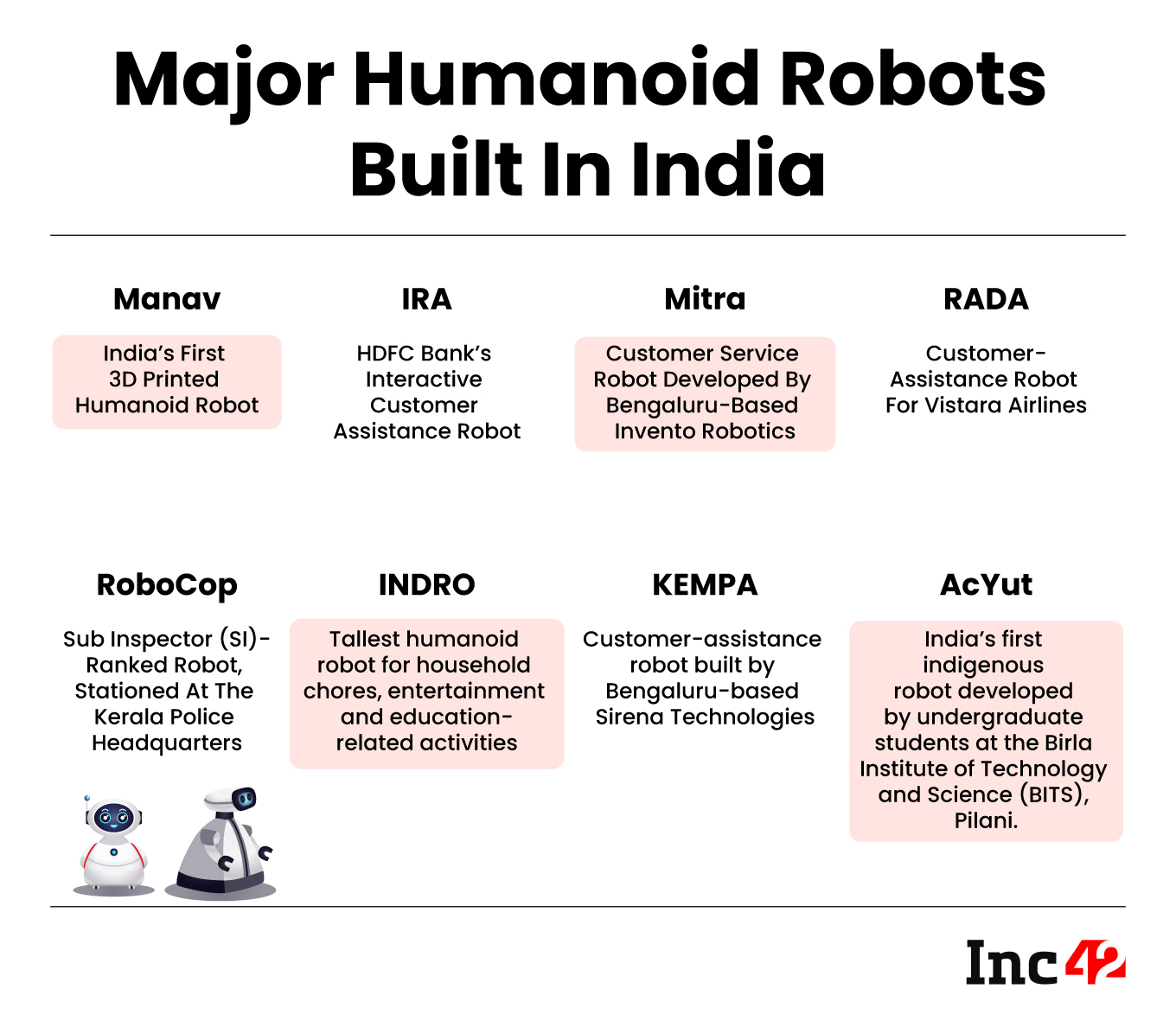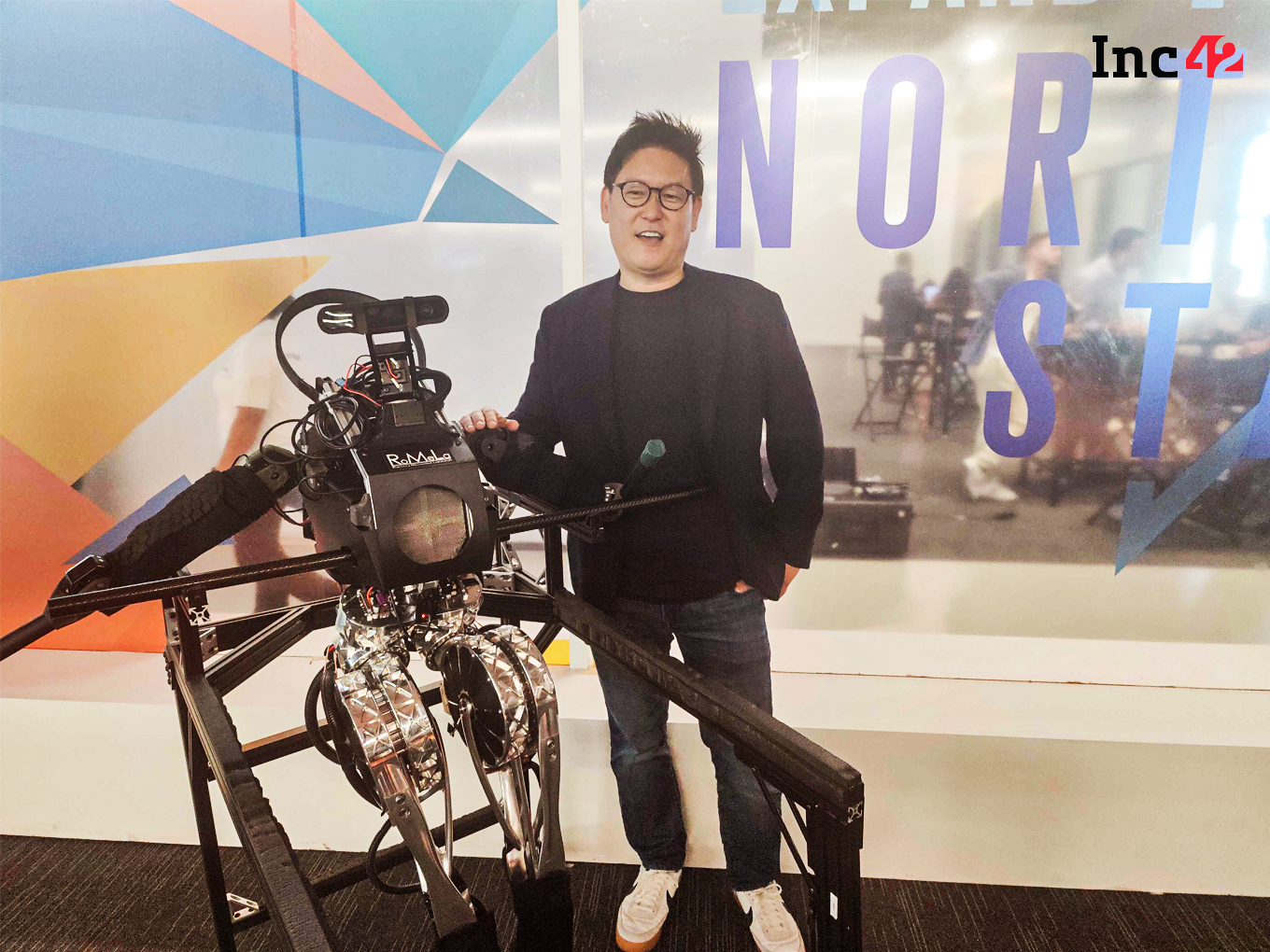Inc42 interacted with Hong on the sidelines of GITEX Global 2023 in Dubai, where the robot was displayed
During lab tests, ARTEMIS clocked a speed of 2.1 metres per second, making it the world’s fastest-walking humanoid robot
In India, Manav is the first 3D-printed humanoid robot that does push-ups, headstands and plays soccer
“Three years ago, my thoughts were – I would love to have these robots living with me in the future. But I will be lucky if it happens while I am alive. If you ask me today, I would say I have changed my thinking,” said Dennis Hong, who has developed the world’s fastest humanoid robot called ARTEMIS. Inc42 had an interaction with Hong on the sidelines of GITEX Global 2023 in Dubai, where the robot was displayed.
During lab tests, ARTEMIS clocked a speed of 2.1 metres per second, making it the world’s fastest-walking humanoid robot.
The UCLA Samueli School of Engineering has developed this full-sized humanoid robot with a first-of-its-kind technology. Researchers at the Robotics and Mechanisms Laboratory (RoMeLa) at UCLA have designed ARTEMIS, the first humanoid robot in academia that can run and the third in the world, after Honda and Boston Dynamics.
ARTEMIS, short for advanced robotic technology for enhanced mobility and improved stability, debuted in the 2023 RoboCup, the latest edition of the Robot World Cup Initiative. This global event features intelligent robots demonstrating various capabilities. The official goal of RoboCup is to create a team of robots that can defeat the human World Cup champions by 2050. For context, RoMeLa has won the RoboCup world championship five times.
As Hong shared, internally, ARTEMIS stands for ‘a robot that exceeds Messi in soccer’. ‘She’ is partially funded by the U.S. Office of Naval Research (ONR). Also, it was funded in part by 232 donors who contributed more than $118,000 through a UCLA Spark crowdfunding campaign.
The ARTEMIS team has many Indian researchers, and Hong believes India is a big tech market where lots of innovations are happening.
“Exciting things have happened in the Indian robotics space. But apart from those, what I see are the students from India. Their eyes sparkle like smart electricity; they are passionate, and I think that [enthusiasm] shows up in the innovative technologies India is now building,” added Hong.
According to a report by Precedence Research, globally, the humanoid robot market stood at $1.62 Bn in 2022. It is estimated to hit $28.7 Bn by 2032, at a CAGR of 33.3%. As ARTEMIS is still a research project, the primary focus here is to develop a humanoid robot that can function like a human being, and the finer points will be addressed later.
Interestingly, the Asia-Pacific market is expected to witness the fastest growth rate due to technological advancements and a growing demand for enhanced customer experience in countries like China and Japan. In India, Manav is the first 3D-printed humanoid robot that does push-ups, headstands and plays soccer.

Get To Know ARTEMIS, Inside Out
As mentioned, ARTEMIS is considered a ‘she’ named after the Greek goddess of chastity, hunting and the moon. Although a general-purpose humanoid robot, ‘she’ has been specifically developed to study dynamic bipedal locomotion in unstructured surroundings.
For context, bipedalism means movement on two feet, regardless of whether a living being is primarily bipedal. For instance, some primates can walk upright for a short period, displaying bipedal capabilities. Bipedal movement includes running, hopping or walking.
Standing at 4 ft, 8 inches and weighing 85 pounds (38.6 kg), ARTEMIS can walk, run and jump on rough and unstable surfaces without falling. She does not lose her balance even when strongly shoved or otherwise disturbed.
According to Hong, custom-designed torque-controlled proprioceptive actuators have been used for ARTEMIS instead of position-controlled servo motors. The former resembles how biological nerve endings in the muscles and joints synchronously work during movement, ensuring smooth motion for mobile robots.
In contrast, servo motors enable precision positioning in a controlled environment (think of robotic welding) but cannot manage the highly dynamic movements of running or jumping robots. Essentially, the technology for fast-moving legged robots must replicate the swing and the spring that human muscles can provide so easily.
“So, this robot does not use AI for locomotion; it is all model-based [for faster and accurate movement]. However, it is smart in the sense that it can recognise things and make decisions which are automated. So, for the locomotion – the moving/jumping part – it is all model-based, and making reception and taking decisions are all AI,” explained Hong.
This combined approach enables ARTEMIS to walk and run on uneven terrains.
Another major advantage is that the robot’s actuators are electrically driven rather than controlled by hydraulics. As a result, ARTEMIS makes less noise, operates more efficiently than robots with hydraulic actuators and is cleaner because hydraulic systems are notorious for leaking.
ARTEMIS has custom-designed force sensors on each foot and has cameras and an orientation unit in her head to help her perceive the surroundings.
“Here’s a fun fact. ARTEMIS wears regular shoes made for humans, and she wears size 4. ARTEMIS prefers Nike. #justdoit,” chuckled Hong.
Rough Terrain Ahead?
Hong said the ARTEMIS team started working in 2018 with a paper-and-pencil calculation. After maths said this technology would work, they did the fundraising in 2019.
“Then, in 2020, Covid happened, and we had to shut down our lab. But that did not stop us. We started working remotely, and in March 2023, we had the official launch,” he added.
But this is just the beginning of a long journey.
Hong cannot come up with a timeline when human society will widely accept a robot’s presence among them. Currently, ARTEMIS is shaping up as a soccer player. But in the future, humanoid robots may have the potential to take up various roles, from professional sportspersons to caregivers to drivers and more.
Even if the technology is available soon (for commercial production), there could be other concerns. For instance, safety is a big issue. Consider this. If ARTEMIS is used at home and a baby comes her way when she is walking, what will happen? In all probability, she will step over it.
There is another major issue. Industrial robots, cobots or those carrying out tactical hazardous operations have been designed to operate in specific situations and environments. However, humanoid robots must be primed to adapt dynamically to human environments and habitats.
“So, besides technological issues, other factors need to be considered, and there is no fixed timeline for this right now. But I would like to see this happen in my life. It’s my dream,” concluded Hong.
[Edited by Sanghamitra Mandal]































 Ad-lite browsing experience
Ad-lite browsing experience